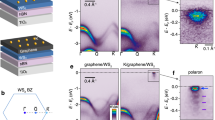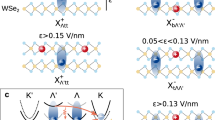Abstract
Engineering layer–layer interactions provides a powerful way to realize novel and designable quantum phenomena in van der Waals heterostructures1,2,3,4,5,6,7,8,9,10,11,12,13,14,15,16. Interlayer electron–electron interactions, for example, have enabled fascinating physics that is difficult to achieve in a single material, such as the Hofstadter’s butterfly in graphene/boron nitride (hBN) heterostructures5,6,7,8,9,10. In addition to electron–electron interactions, interlayer electron–phonon interactions allow for further control of the physical properties of van der Waals heterostructures. Here we report an interlayer electron–phonon interaction in WSe2/hBN heterostructures, where optically silent hBN phonons emerge in Raman spectra with strong intensities through resonant coupling to WSe2 electronic transitions. Excitation spectroscopy reveals the double-resonance nature of such enhancement, and identifies the two resonant states to be the A exciton transition of monolayer WSe2 and a new hybrid state present only in WSe2/hBN heterostructures. The observation of an interlayer electron–phonon interaction could open up new ways to engineer electrons and phonons for device applications.
This is a preview of subscription content, access via your institution
Access options
Subscribe to this journal
Receive 12 print issues and online access
$259.00 per year
only $21.58 per issue
Buy this article
- Purchase on SpringerLink
- Instant access to full article PDF
Prices may be subject to local taxes which are calculated during checkout




Similar content being viewed by others
References
Mak, K. F., McGill, K. L., Park, J. & McEuen, P. L. The valley Hall effect in MoS2 transistors. Science 344, 1489–1492 (2014).
Alden, J. S. et al. Strain solitons and topological defects in bilayer graphene. Proc. Natl Acad. Sci. USA 110, 11256–11260 (2013).
Lee, C. H. et al. Atomically thin p–n junctions with van der Waals heterointerfaces. Nat. Nanotech. 9, 676–681 (2014).
van der Zande, A. M. et al. Tailoring the electronic structure in bilayer molybdenum disulfide via interlayer twist. Nano Lett. 14, 3869–3875 (2014).
Yankowitz, M. et al. Emergence of superlattice Dirac points in graphene on hexagonal boron nitride. Nat. Phys. 8, 382–386 (2012).
Ponomarenko, L. A. et al. Cloning of Dirac fermions in graphene superlattices. Nature 497, 594–597 (2013).
Dean, C. R. et al. Hofstadter’s butterfly and the fractal quantum Hall effect in moiré superlattices. Nature 497, 598–602 (2013).
Hunt, B. et al. Massive Dirac fermions and Hofstadter butterfly in a van der Waals heterostructure. Science 340, 1427–1430 (2013).
Yang, W. et al. Epitaxial growth of single-domain graphene on hexagonal boron nitride. Nat. Mater. 12, 792–797 (2013).
Shi, Z. et al. Gate-dependent pseudospin mixing in graphene/boron nitride moiré superlattices. Nat. Phys. 10, 743–747 (2014).
Mak, K. F., Lee, C., Hone, J., Shan, J. & Heinz, T. F. Atomically thin MoS2: a new direct-gap semiconductor. Phys. Rev. Lett. 105, 136805 (2010).
Splendiani, A. et al. Emerging photoluminescence in monolayer MoS2 . Nano Lett. 10, 1271–1275 (2010).
Rivera, P. et al. Valley-polarized exciton dynamics in a 2D semiconductor heterostructure. Science 351, 688–691 (2016).
Yu, H. Y., Wang, Y., Tong, Q. J., Xu, X. D. & Yao, W. Anomalous light cones and valley optical selection rules of interlayer excitons in twisted heterobilayers. Phys. Rev. Lett. 115, 187002 (2015).
Klimchitskaya, G. L., Mohideen, U. & Mostepanenko, V. M. The Casimir force between real materials: experiment and theory. Rev. Mod. Phys. 81, 1827–1885 (2009).
Woods, L. M. et al. A materials perspective on Casimir and van der Waals interactions. Preprint at http://arxiv.org/abs/1509.03338 (2015).
Price, P. J. Two-dimensional electron transport in semiconductor layers. I. Phonon scattering. Ann. Phys. 133, 217–239 (1981).
Rossi, F. & Kuhn, T. Theory of ultrafast phenomena in photoexcited semiconductors. Rev. Mod. Phys. 74, 895–950 (2002).
Peierls, R. E. Quantum Theory of Solids (Oxford Univ. Press, 1955).
Bardeen, J., Cooper, L. N. & Schrieffer, J. R. Theory of superconductivity. Phys. Rev. 108, 1175–1204 (1957).
Lee, J. J. et al. Interfacial mode coupling as the origin of the enhancement of Tc in FeSe films on SrTiO3 . Nature 515, 245–248 (2014).
Ge, J.-F. et al. Superconductivity above 100 K in single-layer FeSe films on doped SrTiO3 . Nat. Mater. 14, 285–289 (2015).
Chen, J.-H., Jang, C., Xiao, S., Ishigami, M. & Fuhrer, M. S. Intrinsic and extrinsic performance limits of graphene devices on SiO2 . Nat. Nanotech. 3, 206–209 (2008).
Farmer, D. B. et al. Utilization of a buffered dielectric to achieve high field-effect carrier mobility in graphene transistors. Nano Lett. 9, 4474–4478 (2009).
Jones, A. M. et al. Optical generation of excitonic valley coherence in monolayer WSe2 . Nat. Nanotech. 8, 634–638 (2013).
Geick, R., Perry, C. H. & Rupprecht, G. Normal modes in hexagonal boron nitride. Phys. Rev. 146, 543–547 (1966).
Serrano, J. et al. Vibrational properties of hexagonal boron nitride: inelastic X-ray scattering and ab initio calculations. Phys. Rev. Lett. 98, 095503 (2007).
Sahin, H. et al. Anomalous Raman spectra and thickness-dependent electronic properties of WSe2 . Phys. Rev. B 87, 165409 (2013).
Watanabe, K., Taniguchi, T. & Kanda, H. Direct-bandgap properties and evidence for ultraviolet lasing of hexagonal boron nitride single crystal. Nat. Mater. 3, 404–409 (2004).
Cardona, M. Light Scattering in Solids I Vol. 8, 85–92 (Springer, 1983).
Song, J. C. W., Shytov, A. V. & Levitov, L. S. Electron interactions and gap opening in graphene superlattices. Phys. Rev. Lett. 111, 266801 (2013).
Wang, L. et al. One-dimensional electrical contact to a two-dimensional material. Science 342, 614–617 (2013).
Acknowledgements
We thank S. Kahn for technical suggestions on heterostructure preparation and J. Yuk for fruitful discussions on sample characterization. This work was primarily supported by the Director, Office of Science, Office of Basic Energy Sciences, Materials Sciences and Engineering Division of the US Department of Energy under Contract No. DE-AC02-05-CH11231 (van der Waals heterostructures program, KCWF16), and was supported in part by previous breakthroughs obtained through the Laboratory Directed Research and Development Program of Lawrence Berkeley National Laboratory under US Department of Energy Contract No. DE-AC02-05CH11231. F.W. also acknowledges support from a David and Lucile Packard fellowship. S.T. acknowledges support from NSF CAREER award DMR 1552220. Growth of hexagonal boron nitride crystals was supported by the Elemental Strategy Initiative conducted by the MEXT, Japan and a Grant-in-Aid for Scientific Research on Innovative Areas ‘Science of Atomic Layers’ from JSPS.
Author information
Authors and Affiliations
Contributions
F.W., J.K. and C.J. conceived the research. C.J. and J.K. carried out optical measurements. C.J. and F.W. performed theoretical analysis. J.K., C.J., J.S., Z.S. and M.K. fabricated gate-tunable van der Waals heterostructures. B.C., X.F. and S.T. grew WSe2 crystals. K.W. and T.T. grew hBN crystals. All authors discussed the results and wrote the manuscript.
Corresponding author
Ethics declarations
Competing interests
The authors declare no competing financial interests.
Supplementary information
Supplementary information
Supplementary information (PDF 368 kb)
Rights and permissions
About this article
Cite this article
Jin, C., Kim, J., Suh, J. et al. Interlayer electron–phonon coupling in WSe2/hBN heterostructures. Nature Phys 13, 127–131 (2017). https://doi.org/10.1038/nphys3928
Received:
Accepted:
Published:
Issue Date:
DOI: https://doi.org/10.1038/nphys3928
This article is cited by
-
High-purity and stable single-photon emission in bilayer WSe2 via phonon-assisted excitation
Communications Physics (2025)
-
3D hydrogen-like screening effect on excitons in hBN-encapsulated monolayer transition metal dichalcogenides
Scientific Reports (2024)
-
Observation of phonon Stark effect
Nature Communications (2024)
-
Tunable phononic coupling in excitonic quantum emitters
Nature Nanotechnology (2023)
-
Coherent dynamics of strongly interacting electronic spin defects in hexagonal boron nitride
Nature Communications (2023)



